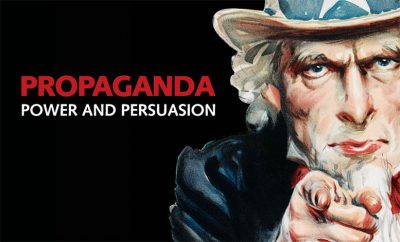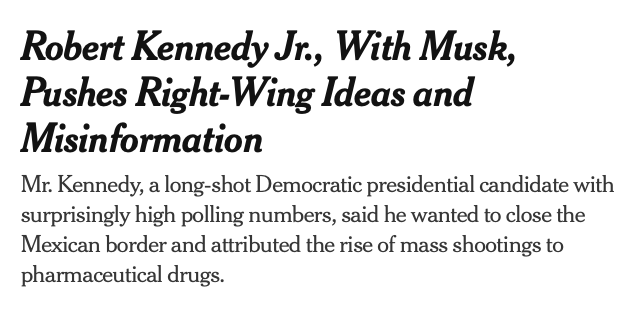The Subtle Art of Propaganda
Courtesy of The New York Times

All Global Research articles can be read in 51 languages by activating the Translate Website button below the author’s name.
To receive Global Research’s Daily Newsletter (selected articles), click here.
Click the share button above to email/forward this article to your friends and colleagues. Follow us on Instagram and Twitter and subscribe to our Telegram Channel. Feel free to repost and share widely Global Research articles.
***
Propaganda comes in many forms, but perhaps no media outlet has perfected the subtlety of its art like the once-venerable – or, at least, once credible – New York Times.
Two examples appeared to me today and I believe they are eminently worthy of analysis, so that we can see how fine an art it is that this organ of propaganda practices.
First, a brief foreword.
I grew up reading the Times, looking forward to its massive Sunday edition in particular, and admiring the prose that graced its journalistic pages.
I began to become suspicious of their credibility when a series of articles by one Judith Miller appeared in the build-up to the illegal invasion of Iraq orchestrated by George Bush and Colin Powell. Nowadays I have relegated this “institution” to a worthless abyss. If and when they actually do publish something truthful, I regard the contribution as a sly way to seduce readers to the dross that fills the other pages.
They are not alone. Those “liberal” and “objective” and “wise” newspapers and magazines – The New Yorker, The New York Review of Books, The Atlantic and so on – join the ranks nowadays as examples of shallow, deceptive and ultimately untrustworthy mouthpieces. I once enjoyed their contributions, even while retaining a skeptical view of any publication that depended on advertising revenue. Now I conclude that these media are both irrelevant and dangerous.
I’d like to describe, however, their accomplished artistry when it comes to pushing their points of view.
The first example appears in this Times headline: “Nazi Symbols on Ukraine’s Front Lines Highlight Thorny Issues of History.”
The word “thorny” is priceless. The Times has been a propulsive advocate of war in the Ukraine, taking the side of Zelensky without reserve, it seems, and successfully suppressing virtually anything that gives credence to the Russian cause. Nonetheless, enough truth has begun to flow out, from other sources, that even the eminent Times must pay homage to – truth, for example, that pertains to the Nazi-affiliations of the Ukraine soldiery.
The fervor of the Deep State West to support the Ukraine cause against Russia would not permit such an inconvenient admission until the obvious could no longer be concealed. The result is “Nazi symbols” – not, mind you, Nazism – and “thorny issues.” “Thorny” in particular is a beautiful feint, suggesting a little glitch, a pebble in a shoe, a nagging but minor matter.
The horror of Nazism, the horror of Nazism embraced by a corrupt Ukrainian regime that has murdered its own citizens and now sends its conscripts to needless death, has been mitigated, reduced to a symbolic presence, a small pin-prick, as it were. The Times headline is a minor masterpiece of semi-truth-telling in the service of larger deceptive aims.
The second example occurs in a sentence, again from the Times, which itself is part of a flagrant hit-piece against Robert F. Kennedy, Jr.: “Mr. Kennedy, who announced his 2024 presidential campaign in April, is himself a leading vaccine skeptic, and has promoted other conspiracy theories.”
Here I wish to call attention to the legerdemain that brings us to associate skepticism about vaccines – which there is plenty of evidence to justify – with the decades-old canard of conspiracy theory. Look at how the grammar and structure of the sentence is used to convey that to be a so-called vaccine skeptic means to promote a conspiracy theory, and in RFK Jr.’s case, according to the Times, a promoter of other conspiracy theories too, although the author feels no need to flesh these out.
In other words, questioning the safety and efficacy of vaccines, wishing to understand their consequences and the role of Big Pharma in their promotion, inquiring into the various ingredients of vaccines – all of this shows a kind of dreaded “skepticism,” which is then linked to “conspiracy theory.”
Actually, in addition to being a deviously good bit of propaganda, the offending sentence may also hint unintentionally at a real truth, which is this: anyone who dares to try to think independently, to engage in research, to criticize, doubt, wonder about or wish to look more deeply into an issue is anathema.
If I don’t trust the Warren Commission’s conclusions about JFK’s death, I’m a conspiracy theorist. If I query the official “narrative” – how I hate that overused word, by the way, for its implication that everything is spin and truth is relative – then I’m a conspiracy theorist. Worse yet, should I be audacious enough to challenge the gospel of vaccine salvation, I’m a conspiracy theorist – and poor RFK Jr., who has been a left wing Democrat all his life, is now miraculously transformed into a right wing misinformationist!
See how it works?
It’s all in the language, the extremely deft and subtle and artistic use of words in the service of a kind of propaganda that is so good it goes virtually undetected as one reads.
*
Note to readers: Please click the share button above. Follow us on Instagram and Twitter and subscribe to our Telegram Channel. Feel free to repost and share widely Global Research articles.
Dr. Garcia is a Philadelphia-born psychoanalyst and psychiatrist who emigrated to New Zealand in 2006. He has authored articles ranging from explorations of psychoanalytic technique, the psychology of creativity in music (Mahler, Rachmaninoff, Scriabin, Delius), and politics. He is also a poet, novelist and theatrical director. He retired from psychiatric practice in 2021 after working in the public sector in New Zealand. Visit his substack at https://newzealanddoc.substack.com/
He is a regular contributor to Global Research.



